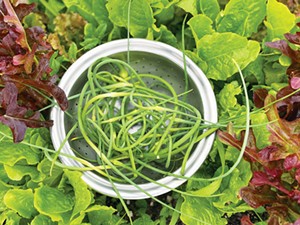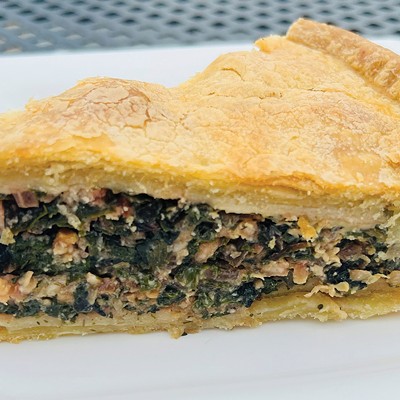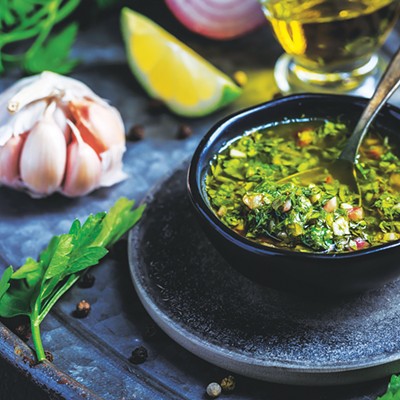"Have you got your garden in yet?" It's a question I'm often asked in springtime and I'm never quite sure how to respond because there's never really a point when my garden is "in" or "out." The first plantings actually happen in autumn of the previous season, after tender annuals like tomatoes and squash have been killed off by frost. Tiny lettuce seeds sprinkled over bare soil readily overwinter, happily blanketed by snow to emerge when the soil reaches just the right temperature. And garlic, perhaps my favorite kitchen ingredient of all, is also planted in the fall. In a warm November, the fat, juicy cloves send up little green shoots that will eventually stick up out of the snow, a happy reminder that warmer days will indeed return.
The garlic bulbs are generally ready to harvest the following July. However, what I look forward to as much as the actual cloves of garlic are the green scapes that pop out in late spring. Garlic scapes are unopened flower buds that emerge from hardneck garlic plants on a graceful, curling and very edible tendril. Gardeners have long known that removing the scapes will result in plumper, large heads of garlic because the plant will divert its resources into growing the bulb, rather than developing a bloom. The tender shoots have a delicate, almost sweet garlic flavor that is well-suited to recipes using raw garlic such as pesto, salsa and salad dressings. They are also delicious in cooked applications and are mild enough to use in a stir fry. They can be used anywhere you'd include a regular clove of garlic, but because the flavor is so mild you'll want to include more than you would if you were using regular garlic.Scapes have a nutritional profile similar to garlic cloves and are rich in nutrients and antioxidants. Savvy gardeners have enjoyed them for years, but it's only in the last decade or so that they've become common at farmers markets. "When my dad was running the farm many years ago it was mostly folks from the Asian community who'd come and buy them," explained Jacque Simpson, who co-owns Suttill's Garden in Springfield with her daughter, Caitlin. "Before long the chefs started asking for them, and now these days they're pretty popular across the board." Simpson came up with a recipe for garlic scapes last year that has quickly become a family favorite. "I blanch them in boiling water for about 30 seconds to make them pliable so I can weave them into little rings, then I dip them in tempura batter and fry them up into garlic rings." The blanched rings even freeze well (unbattered), Simpson pointed out, so they're able to enjoy them for months to come. Like most seasonal delights, these tasty garlic scapes will only be available for a short time at local farm stands and markets.
Asparagus and garlic scape stir fry
12 ounces pencil-thin asparagus (snow peas are also delicious)
12 ounces garlic scapes
1 tablespoon neutral oil (avocado works well)
1 tablespoon grated ginger
1 jalapeno, optional
¾ cup packed basil leaves
Trim the tough ends of the asparagus and snap the flower heads off the scapes if they're fairly developed, then cut the asparagus and scapes into 2-inch pieces. Heat the oil in a wok or large skillet until almost smoking, then add the asparagus and scapes to the hot pan, tossing to coat with the oil. Continue to stir-fry over high heat for another minute, until the vegetables are bright green and just barely cooked through. Add the ginger jalapenos (if using) and stir fry for another minute. Remove from heat and stir in the soy sauce and bails leaves. Season to taste with salt and pepper, then serve immediately.
Bagna cauda
This garlic-laced recipe hails from the Italian region of Piedmont. "Bagna cauda" loosely translates to "hot bath" and is a preparation particularly well suited to summer as it's intended to be served as a dip for freshly cut vegetables. We use it many ways at my house, including as a spread for the world's best garlic bread or to toss with pasta for a decadent yet simple supper. Don't get too hung up on the anchovy component of this recipe. The garlic is truly the star of the show, with the anchovies playing a supportive role much as they do in caesar salad dressing.
1 1/2 cups whole milk
8-12 oil-packed anchovy filets (more or less to taste)
1 ½ cups chopped garlic scapes
¼ cup heavy cream
1 tablespoon unsalted butter
¾ cup olive oil
Salt and freshly ground pepper, to taste
Combine the milk and diced garlic scapes in a small saucepan and bring to a simmer over medium heat. Simmer uncovered for about 15 minutes until the milk is thick and reduced but not totally evaporated. Scrape the reduced milk and garlic mixture into a blender or food processor. Warm the cream, butter and olive oil briefly in the microwave until warm but not hot, then with the blender motor running, slowly pour in the warm oil mixture in a thin stream to create an emulsification with a consistency similar to mayonnaise. Taste for seasoning and transfer to a small crockpot set on warm or a fondue pot and serve immediately alongside cut vegetables and bread. Leftover bagna cauda can be refrigerated for up to two weeks or frozen. Reheat gently to prevent it from separating.


















